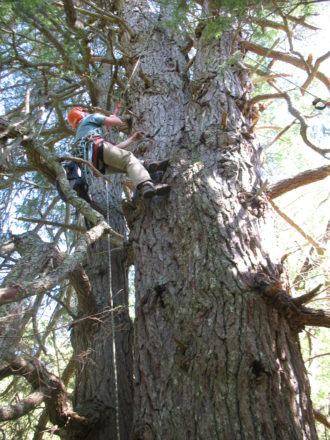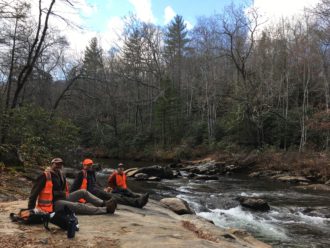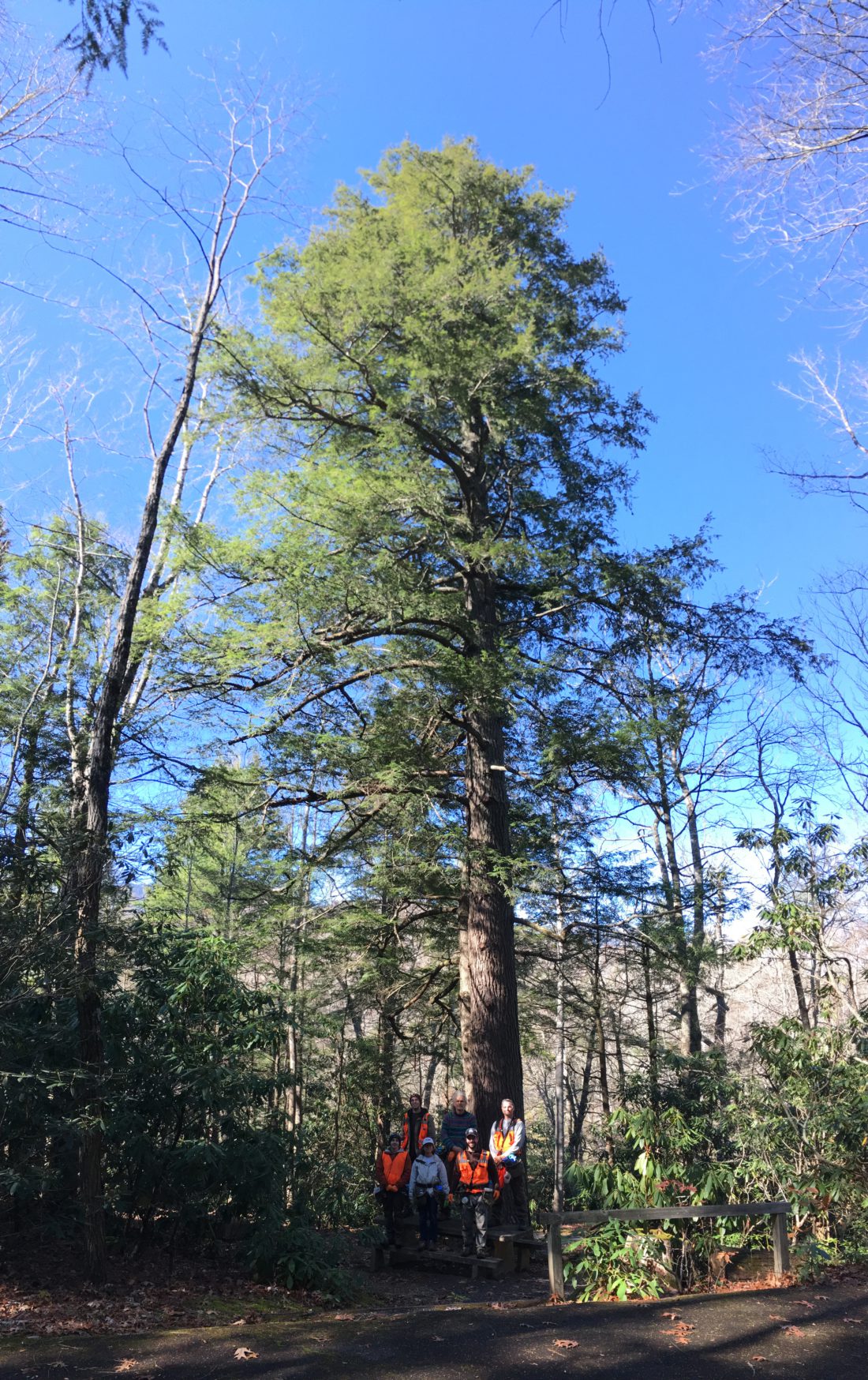Margot Wallston is committed to playing the long game.
As director of the Hemlock Restoration Initiative, a program of Asheville-based nonprofit WNC Communities, Wallston leads the local battle against the hemlock woolly adelgid. The invasive insect, which originated in Asia and first appeared in the state in 1995, now infests all of Western North Carolina and has already killed hundreds of thousands of trees.
Since the HRI’s founding with $100,000 from the N.C. Department of Agriculture and Consumer Services in 2014, Wallston says, the program and its partners have been fighting back. Over 85,000 hemlocks have been treated with chemicals to kill the adelgid, populations of beetles that prey on the pest have been established in local forests, and researchers have honed methods for growing new trees to restore what’s been lost. While the adelgid will likely never disappear from the landscape, she explains, momentum is building to keep it under control, helped along by state financial support.
That momentum is in danger of stalling — not because the adelgid has become wilier, but because of dysfunction at the N.C. General Assembly. Agriculture Commissioner Steve Troxler and former Rep. Chuck McGrady, R-Henderson, had requested $300,000 of recurring funds for the HRI in the state’s fiscal year 2019-20 budget. Democratic Gov. Roy Cooper then vetoed the budget on June 28, 2019, citing “tax breaks for corporations” inserted by Republican lawmakers.
Budget negotiations have since stalled, and emergency responses to the coronavirus pandemic have further hindered the process. “We’ve been experiencing the same shortages that so many others have been due to COVID and due to last year’s budget never getting passed,” Wallston says. “Those challenges in obtaining that state funding have left us in a bit of a precarious situation.”

A joint proclamation between the HRI and the agriculture department, issued Sept. 2, aims to make the hemlock’s future more secure. The document commits both organizations to pursuing official status for the HRI as a state program with a guaranteed pot of money.
“There is ongoing management that has to be planned for,” says Wallston. “Longevity will not only allow us to do that planning work, but it will also allow us to get some additional funding support from those who want to see it’s not going to die out in a year or two.”
Shady grove
Sandy Stewart, the state’s assistant commissioner of agricultural services, emphasizes that the department sees hemlocks as a vital natural resource worthy of protection. Even without dedicated funding to put toward the HRI, he says, his department continues to support the program: Its Beneficial Insect Lab raises predator beetles that hunt the adelgid, while the N.C. Forest Service operates hemlock nurseries to help repopulate the tree’s range.
Hemlocks prefer to grow along creeks or in coves, notes Chris Sharpton, a forester with the Forest Service. The trees help keep the water clean and cool, he says, benefiting both the broader ecosystem and economically important trout populations.

If the woolly adelgid is allowed to run rampant through a stand of hemlocks, those benefits go away — and new problems emerge. Sharpton says that habitats protected by hemlocks are among the last to dry out during a drought, providing natural lines for wildfire control. Dead hemlock trunks, he continues, can become “large, heavy fuels” for fire, turning that help into a hindrance.
Under rainy conditions, adds Stewart, deadfall from hemlocks can clog up mountain waterways and cause problematic logjams. “A few weeks ago, particularly over in Graham County, there were some torrential rains, and the old hemlocks that were in those streams caused a lot of damage with that much water falling at one time,” he says.
Both severe drought and heavy precipitation are predicted to become more common in WNC over the coming decades due to climate change, according to the N.C. Climate Science Report recently commissioned by the state Department of Environmental Quality. Hemlocks give the region some resilience to those climate impacts, Stewart says, which makes their preservation even more critical.
By allocating dedicated funds to the HRI, Stewart continues, the General Assembly would build “staying power” into a program that tackles the ongoing threats of deforestation and climate. He says the money would allow the agriculture department to devote at least one full-time staff position to hemlock work and treat more trees.
Growing pains
Stewart and Wallston say their respective organizations are eager to put those changes in place as early as 2021. But McGrady, whom Wallston calls “a champion” for the HRI in the state legislature, cautions that nothing should be taken for granted in an age of COVID-19 and deep political divisions. (McGrady resigned from the General Assembly on Oct. 5 to serve on the N.C. Board of Transportation; see “Into the sunset,” page 9.)
“The state’s budget revenues have clearly been affected by COVID, and while we’ve made it through the last fiscal year OK, the expectation is that the coming fiscal year is going to be quite challenging,” McGrady says. And Troxler, a Republican, faces a challenger this year in Democrat Jenna Wadsworth; McGrady points out that she may set different priorities for department funding if elected.
Asked if her administration would make the same institutional commitment to the HRI as has Troxler, Wadsworth said she understands the importance of hemlocks to the Appalachian ecosystem and generally supports work to combat the woolly adelgid infestation. However, she raised concerns about the HRI’s use of the Young Offenders Forest Conservation Program — commonly known as BRIDGE — an initiative of the N.C. Department of Public Safety that pays prisoners who opt in $1 per day while training them to fight fires and conduct other forestry work.
“I question the exploitation of offenders in order to achieve our agricultural and environmental aims on the cheap,” Wadsworth wrote. “There has to be a better solution to combating such a serious problem because the dependence on essentially unpaid labor is abhorrent.”
Wallston responds that the BRIDGE work crews are “a huge asset for us” and notes that they have treated over 45,000 hemlocks for adelgid control over the past several years. “When BRIDGE crews join us in the field, members frequently express their appreciation for being able to participate in the program and develop the natural resource management skills they learn through the program,” she says. “While a lot of our work is done without BRIDGE crews, when we do get to work together, it’s generally a good day all around.”
No matter who ends up in charge of the department, Wallston continues, the state should recognize the HRI’s progress and potential for protecting forests. She says hemlocks are well adapted to WNC and can fill in voids left when other trees succumb to environmental stressors.
The hemlock, she concludes, “can tolerate a lot of what nature throws at it. The one thing it hasn’t been able to tolerate is the introduction of this novel, invasive pest.”



This seems like a losing battle to me. Treating 85K trees? How many Hemlocks are out there? Millions?
Yes I’m saddened by the attack on hemlocks and other attacks occurring in other species. But aren’t we just throwing good money after bad?
Why do we think we can alter Mother Nature?